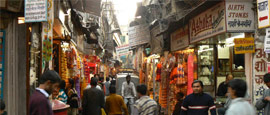Delhi History
For centuries, Delhi was at the heart of the Mughal Empire, and its many historic monuments stand testament to its former glories. However, the area's human history probably dates back 4,000 years or more.
Modern Delhi is really two cities. Old Delhi is a medieval web of narrow, crowded streets woven beneath the Red Fort's imposing walls which was built by Emperor Shah Jahan in the 17th century.
British-built New Delhi boasts broad, leafy boulevards, grand colonial buildings and gracious Lutyens bungalows.
The control of Muslim dynasties over the city lasted five centuries from 1200 and had a major impact on Delhi. It was during this period that landmarks such as Qutb Minar and Quwwat-al-Islam were constructed, as well as a number of forts and townships.
In 1720, the Mughal Empire’s influence started to wane as the Hindu Maratha Empire gained power. Tussles between the two continued for another 100 years until Delhi fell to the forces of the East India Company in 1857.
By the following year, the city was under the control of the British Empire. By 1911, Delhi became the capital of India when the British moved their headquarters from Kolkata.
New Delhi, a new quarter designed by British architect Edwin Lutyens to house government buildings, was officially inaugurated in 1931 after its construction was delayed due to WWI.
New Delhi became the seat of the Government of India after independence in 1949. During the partition of India, thousands of Hindu and Sikh refugees fled to Delhi.
Since then, the city has prospered, attracting migrants from the rest of India. But a rapidly expanding population has brought greater poverty to the city – almost half of Delhi's inhabitants live in slums.
In 2010, Delhi successfully hosted the Commonwealth Games, despite some pre-games scepticism around the world.
Today, Delhi is the largest commercial centre in Northern India.
Did you know?
• Delhi is home to three UNESCO World Heritage sites: Humayun’s Tomb, Qutb Minar and the Red Fort Complex.
• Former Pakistani president Pervez Musharraf was born in Delhi in 1943.
• Delhi launched its first metro trains in 2002.
Do you have any Feedback about this page?
© 2026 Columbus Travel Media Ltd. All rights reserved. No part of this site may be reproduced without our written permission, click here for information on Columbus Content Solutions.




 You know where
You know where